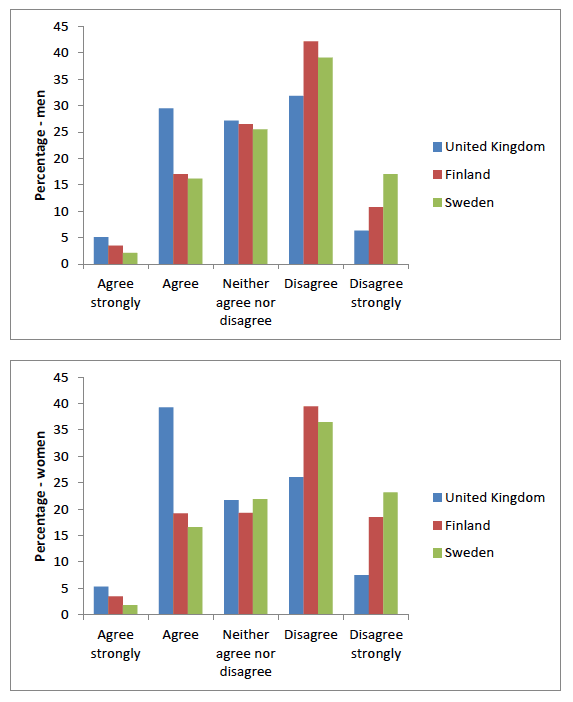New perspectives on the gender pay gap: trends and drivers
This report explains the different measures of the gender pay gap and considers how it has been changing over time. It also considers underlying drivers and describes Scottish Government policy intended to help encourage the decline of the pay gap.
9. Attitudes to Division of Gender Roles in the Home and Workplace
The surprisingly high gender pay gap in countries with positive gender equality policies suggests that traditionalist attitudes towards gender roles in the home and workplace continue to hold sway. These continuing attitudes may result in women continuing to be more likely to be doing unpaid work, despite also being more likely to be in (part-time) work.
The British Social Attitudes ( BSA) survey provides some insight into public attitudes towards the division of gender roles in the home and workplace. In Britain, support for a traditional division of gender roles has declined over time, though substantial support remains for women having the primary caring role when children are young.
According to the BSA survey in 2012, 33% thought that a mother should stay at home when there is a child under school age, compared with 64% in 1989. The most popular choice by survey respondents in 2012 is for the mother to work part-time (26% in 1989, 43% in 2012).
The survey also suggests that while the male breadwinner family system has been in decline for at least half a century, concerns about the balance of 'work-family conflict' have only been voiced more recently, i.e. where the demands of a job or inflexible working pattern conflict with family commitments.
It implies that with the rise in mothers' labour market participation, there is a role for policy measures that seek to reduce family-work conflict. However it should not necessarily be expected that this will lead to a reduction in the pay gap. It is conceivable that more workplace flexibility could even increase the pay gap if more women than men choose to take up flexible or part-time working patterns.
Underlying these choices is a persistent general view that it is preferable for women, rather than men, to take on more of the work disruption associated with having a family. When asked to consider a family with a child under school age and to choose the best way for them to organise their family and work life, the most popular approach, selected by almost four in ten people, is for the mother to work part-time and the father to work full-time. Only 5% suggested that it would be preferable for both the mother and father to work part-time to share the childcare.
International data from the European Social Survey shows that high proportions of both men and women in the UK agree or strongly agree with the following statement: " Women should be prepared to cut down on paid work for sake of family". A higher proportion of women than men agreed with this statement.
Figure 12: Percentage who agree that women should be prepared to cut down on paid work for sake of family, 2010 UK

Source: European Social Survey, Family, work and well-being module ( ESS2 2004, ESS5 2010)
Attitudes underlying women and men's labour market choices remain quite traditional whilst the distribution of unpaid work in the home remains highly gendered. Whilst this persists, it is increasingly important to emphasise the economic value of unpaid work that women do more of, and its importance to the wider economy.
KEY MESSAGE: Increasing female labour market participation alone will not necessarily improve the pay gap, whilst inequality of unpaid work increases the pressure on women to find jobs that accommodate greater work disruption due to caring and a greater burden of unpaid work.
There may be 'structural lag' in terms of attitudes towards gender roles in unpaid work, including housework, changing more slowly than increasing acceptance of the idea of gender-neutral 'adult worker' families where both partners are expected to work.
Contact
There is a problem
Thanks for your feedback